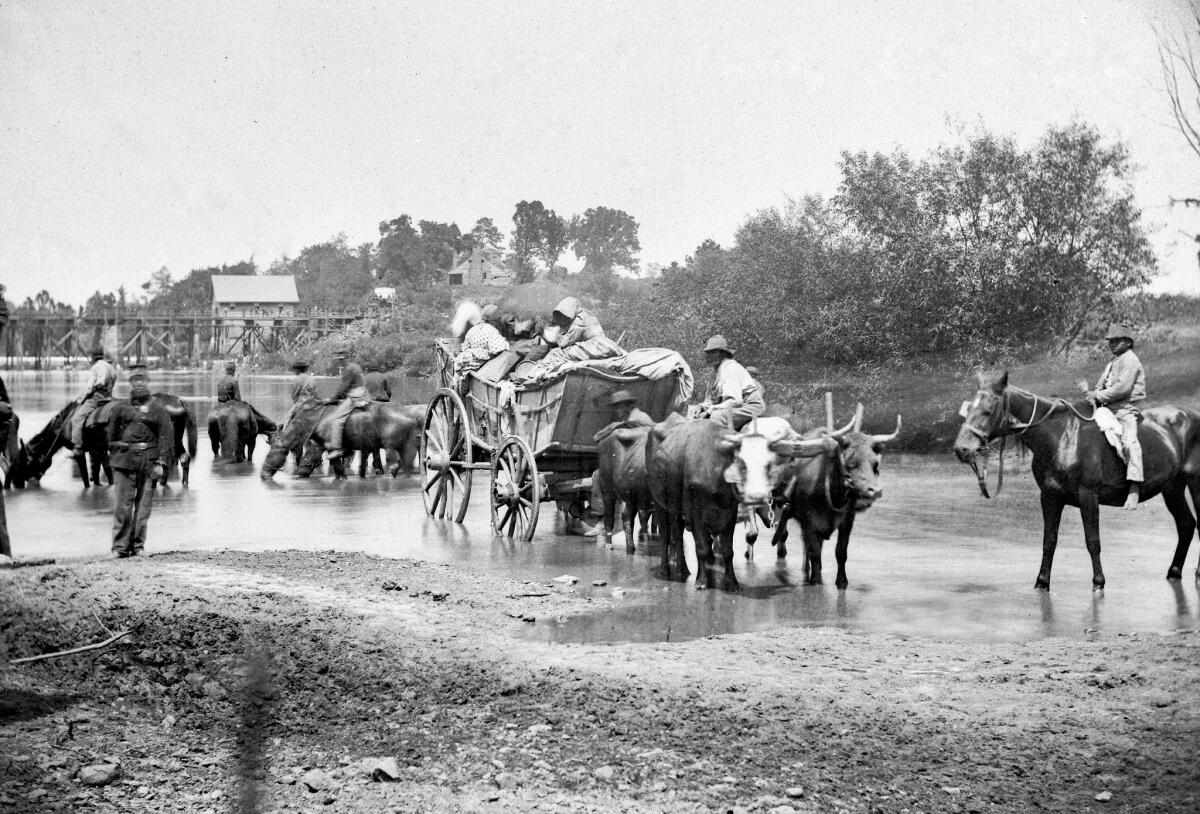Review: ‘Gateway to Freedom’ reveals underground railroad history

Eric Foner’s vivid new book, about the semi-organized system to aid runaway slaves popularly known as the underground railroad, makes an excellent companion to “Reconstruction,” his magisterial 1988 account of the post-Civil War effort to bring racial justice to the American South. In both histories, Foner appreciates the crucial role of white radicals while emphasizing that black people were active combatants in the struggles to end slavery and to establish meaningful freedom for African Americans.
------------
FOR THE RECORD:
“Gateway to Freedom”: A review of Eric Foner’s book “Gateway to Freedom: The Hidden History of the Underground Railroad” in the Arts & Books section of this edition misspells the first name of abolitionist Sydney Howard Gay as Sidney. The error was caught after the section went to press.
------------
Like its predecessor, “Gateway to Freedom” makes palpable the nuances and complexities of the past. “The ‘underground railroad,’” Foner writes, “should be understood not as a single entity but as an umbrella term for local groups that employed numerous methods.” The New York Vigilance Committee, founded in 1835, was typical: a small, interracial band of abolitionists who took open, legal actions to protect free African Americans from being kidnapped and sold into slavery, while also covertly helping runaway slaves reach safety in upstate New York, New England and Canada.
David Ruggles, a free black man who was the committee’s driving force for its first five years, is one of several grass-roots activists given lively thumbnail sketches by Foner. Ruggles’ conviction that combating slavery required direct action — and not necessarily nonviolent direct action — would come to be shared by more abolitionists after the passage of the Fugitive Slave Law of 1850.
During the 1840s, thanks in large part to the advocacy of vigilance committees in New York and elsewhere, many Northern states passed laws prohibiting their public officials from participating in the recapture of slaves and adopting the “freedom principle” that slaves brought by their owners to a state where slavery was illegal automatically became free.
This was the period when the term underground railroad came into widespread use, and if infuriated Southerners tended to overestimate the scope and power of ad hoc arrangements that helped perhaps 10,000 to 50,000 runaway slaves during that decade (a pitiful percentage of the 4 million enslaved), they accurately perceived that legal maneuvers and covert action combined to undermine what they saw as their sacred property rights.
The Fugitive Slave Law changed all that. It overrode Northern personal liberty laws and enabled the federal government to force local authorities and citizens to assist in the recapture of escaped slaves. (Foner notes the irony inherent in this huge expansion of federal power to appease the nation’s loudest advocates of states’ rights.) If slaveholders thought it would cow abolitionists, they were mistaken.
“The Fugitive Slave Law reinvigorated and radicalized the underground railroad,” Foner writes. From Norfolk, Va., and Wilmington, Del., in the slave states to Albany and Syracuse in upstate New York, key way stations on the route to Canada, activists intensified their efforts and solidified informal arrangements into a strong if still loose network whose hub was New York City.
Foner gets his detailed information about the workings of the underground railroad during this fraught period from two invaluable contemporary documents. The first is a Record of Fugitives compiled in 1855-56 by Sydney Howard Gay, white editor of the National Anti-Slavery Standard, who recounted the journeys of more than 200 runaways who passed through his Manhattan offices. The second is the journal of William Still, son of a fugitive slave and leader of the Philadelphia Vigilance Committee, which played a vital role because of southern Pennsylvania’s proximity to Delaware, Virginia and Maryland, sources of most fugitive slaves.
Using these documents and others, Foner puts names and faces to activists less famous than Harriet Tubman (who makes a brief appearance) but more important to the functioning of the underground railroad. While Tubman rescued some 70 slaves, Jermain W. Loguen of Syracuse was credited with assisting 1,500 fugitives; Thomas Garrett, one of the many Quakers active in the underground railroad, helped more than 2,200 people cross the Delaware border to freedom.
Perhaps most indispensable of all was Louis Napoleon, Gay’s right-hand man, who reportedly aided 3,000 slaves escaping from bondage. Although illiterate, Napoleon was involved in several abolitionist-instigated legal proceedings, including one challenging slaveholders’ right to transport their slaves through free states; when the attorney for Virginia sarcastically asked if the Louis Napoleon who launched that case was emperor of France, a lawyer on the other side replied, “A much better man.”
Foner’s able, evocative portraits of men like Napoleon — or Henry Brown, who arrived in Philadelphia after a 24-hour trip by rail and steamboat hidden in a crate “even too small for a coffin” — add human drama to his cogent scholarly study. They buttress his main point: that the underground railroad, instrument and symbol of enslaved African Americans’ determination to achieve freedom, was a major factor in the sectional polarization that led to the Civil War.
Intellectually probing and emotionally resonant, “Gateway to Freedom” reminds us that history can be as stirring as the most gripping fiction.
Smith is a contributing editor of the American Scholar and author of “Real Life Drama: The Group Theatre and America, 1931-1940.”
Gateway to Freedom
The Hidden History of the Underground Railroad
Eric Foner
W.W. Norton: 320 pp., $26.95
------------
For the record: An earlier version of this article misspelled the first name of abolitionist Sydney Howard Gay as Sidney.
------------
More to Read
Sign up for our Book Club newsletter
Get the latest news, events and more from the Los Angeles Times Book Club, and help us get L.A. reading and talking.
You may occasionally receive promotional content from the Los Angeles Times.






